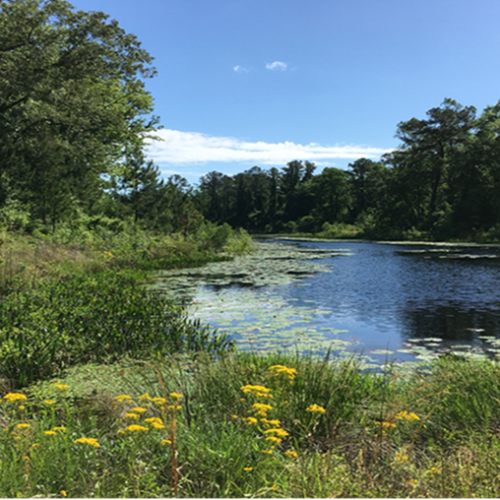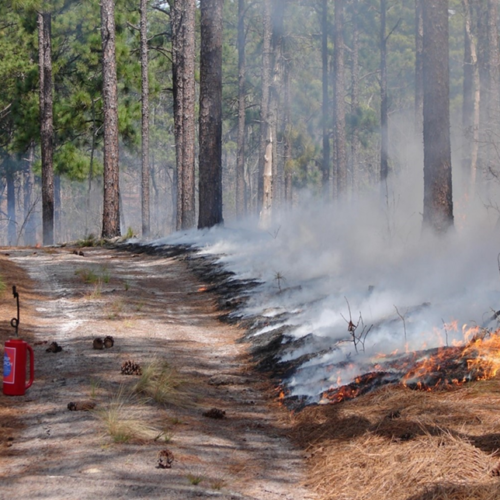Watershed Management

Bayberry Wetland Pond- A stormwater detention basin constructed with a grant from the Clean Water Management Trust Fund.
PWC’s Watershed Management Program is an important element of a multiple-barrier approach to providing safe, award-winning, high-quality water to our customers. Additionally, we must protect our watershed to prevent irreversible degradation that could render the water unsuitable for use as a water supply.
PWC’s Watershed Management Program was established in 1990 with the primary objective of reducing pollutant loadings and stressors entering the Little Cross Creek and Big Cross Creek Watersheds. This results in the following:
- Improved quality of water
- Decreased treatment cost at our water plants
- Improved health of both the general public and aquatic ecosystem
What is a Watershed?
A watershed is a region in which all land drains to a particular body of water or common point. It could be as small as your backyard or as large as any major river basin. Water quality is impacted by many sources within a watershed. A creek that’s clean at one end could be polluted downstream by drainage from other waters.
PWC has two water treatment plants, the P.O. Hoffer Water Treatment Facility, which is located on the Cape Fear River, and the Glenville Lake Water Treatment Facility, which is located on Glenville Lake in the Little Cross Creek Watershed. PWC also operates a pump station on Big Cross Creek, which can pump up to one million gallons of water per day to the Glenville Lake Water Treatment Facility. These three areas are the focus of our watershed management activities.
PWC’s watershed management activities occurring in the Little and Big Cross Creek basins can be grouped into two broad categories:
- Implementing sound land management practices
- Monitoring, maintaining, & improving water quality & quantity
Within each broad category, there are a variety of activities being implemented to achieve different objectives. Success in one area is usually dependent on success in another. For example, good water quality in a stream is directly related to the land use activities occurring around it. This is why a holistic approach to managing the area around a water body is necessary to achieve good water quality.
Land Management
Watersheds staff manages approximately 3,000 acres of forested land buffering our water supply watershed lakes. These natural areas are listed in the North Carolina Registry of Natural Heritage Areas and include highly significant natural features critical to the preservation of North Carolina’s natural diversity. For example, the 262-acre Bonnie Doone Lake natural area boasts the largest old-growth Long Leaf Pine stand remaining in North Carolina, as well as one of less than a dozen enduring in the southeast.
These areas are protected and managed through one or more of the following practices:
- Prescribed/Controlled Burning: Promotes and maintains the longleaf pine and wiregrass ecosystem along with other fire dependent flora.
- Forestry Management: Thinning of dense stands of trees and removing invasive and exotic plant species improves the health of the forest and enhances biodiversity.
- Wetland Management: Promoting native wetland plant species enhances biodiversity and wildlife habitat. Invasive and non-native plant species are controlled by manual removal.
- Erosion Control: Preventing sedimentation of streams and lakes (a major pollution problem across the state) by stabilizing land and stream banks.
Water Quality Management
Management includes monitoring and maintenance of high hazard earthen dams, monitoring water quality through sample collection and analysis, maintaining a shoreline vegetated buffer, surveying and identifying aquatic and shoreline flora, treatment for the removal of aquatic non-native invasive flora, and wildlife habitat management.
Watershed staff co-manages Big Cross Creek and portions of the Cape Fear River while managing lakes and wetland ponds:
- Bonnie Doone Lake
- Kornbow Lake
- Mintz Pond
- Glenville Lake
- Mallard Creek Wetland Pond
- Bayberry Wetland Pond
- Passerine Wetland Pond
Water samples are collected at the headwaters and tailwaters of each lake along with each feeder stream where flow enters into each lake. Samples are also collected at the headwaters and outlet structure of the wetland ponds and at other strategic areas draining into the water supply watershed. Grab samples are collected at base level at sites on the watershed including one sample from Big Cross Creek sub-watershed and are analyzed for the following:
- Dissolved Oxygen
- pH
- Conductivity
- Turbidity
- Temperature
- Fecal Coliform Bacteria
- Ammonia
- Total Phosphorus
- Nitrate
- Nitrite
- TKN Nitrogen
- UV254
- Manganese
- Iron
- Copper
- Nickel
- Zinc
The results are reviewed and abnormalities are investigated.
Education
PWC’s Communications/Community Relations Department coordinates educational outreach promoting environmental awareness and protecting our natural resources. For more information, call (910) 223-4009 or email info@faypwc.com.

Prescribed Burning on Bonnie Doone as part of the Longleaf Wiregrass Ecosystem Restoration Project.


